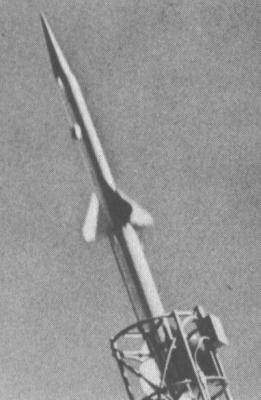Aerophysics Development HTV
In 1953, the Aerophysics Development Corp. received a contract to build a HTV (Hypersonic Test Vehicle) under project MX-2227 for the U.S. Air Force's ARDC (Air Research & Development Command). Aerophysics designed a two stage vehicle, which was first flown in November 1954.
 |
| Photo: via Ordway/Wakeford |
| HTV |
The first stage consisted of seven solid-fueled rockets, which were fired simultaneously and accelerated the HTV to Mach 7 in only 2 seconds. Four Wasp rockets made up the second stage. Both stages were fin-stabilized, using three and four fins, respectively. The Air Force launched more than 40 HTVs until December 1958 for various types of experiments, including aerothermodynamic heating, upper-atmosphere sounding and tests of rocket components.
It must be noted, that "HTV" was a generic term and not a specific name for the Aerophysics vehicle. The term was also used for a number of other rocket configurations of up to 6 stages, which were flown by NACA and NASA.
Specifications
Note: Data given by several sources show slight variations. Figures given below may therefore be inaccurate!
Data for Aerophysics HTV:
| Length | 3.93 m (12 ft 11 in) |
| Diameter | 1st stage: 23 cm (9 in) |
| Weight | 105 kg (231 lb) |
| Speed | Mach 10 |
| Propulsion | 1st stage: 7x solid-fueled rocket 2nd stage: 4x Wasp solid-fueled rocket |
Main Sources
[1] Norman J. Bowman: "The Handbook of Rockets and Guided Missiles", Perastadion Press, 1963
[2] Frederick I. Ordway III, Ronald C. Wakeford: "International Missile and Spacecraft Guide", McGraw-Hill, 1960
[3] White Sands Missile Range History Website (Firing Tables)
Back to Directory of U.S. Military Rockets and Missiles, Appendix 4
Last Updated: 2 December 2004